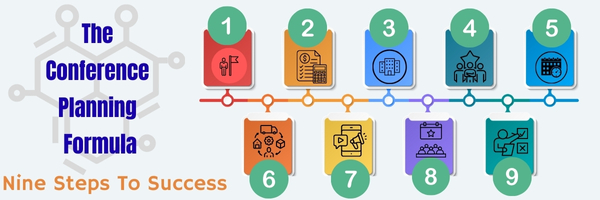
Planning a successful conference isn’t luck—it’s a formula. From the initial strategy to post-event wrap-up, this framework helps planners stay organized, efficient, and focused on results.
Here’s a step-by-step breakdown:
1. Define Your Goals and Audience
Every successful
conference starts with clarity. What do you want attendees to walk away with—a
new skill, insight, connection, or experience? Is your focus on education,
networking, brand awareness, or all of the above? Once your goals are clear,
define your audience: are they industry veterans, first-time attendees,
executives, or students? Understanding both your purpose and your people helps
shape every decision that follows—from content to venue to marketing tone.
2. Build a Budget
Budgeting is more
than crunching numbers—it’s about anticipating needs and building flexibility.
Outline both fixed costs (venue rental, insurance, staffing) and variable costs
(F&B, print materials, speaker fees). Don’t forget hidden line items like
Wi-Fi upgrades or accessibility services. Consider seeking sponsors or in-kind
partners to offset costs or elevate the experience. A good budget isn’t
static—review and adjust it regularly as plans evolve.
3. Choose the Right Venue
The venue sets the
tone. Choose a location that aligns with your goals and is convenient for your
audience—think about proximity to transportation, ADA accessibility, and
overall vibe. Does the space support your session formats (keynotes, breakouts,
exhibit areas)? Check calendars to avoid conflicts with major holidays or
competing industry events. Flexibility in your preferred dates can also give
you negotiating power on rates and concessions.
4. Assemble a Great Team
You can’t do it
alone—and you shouldn’t try. Build a team with complementary strengths and
clear responsibilities. Event leads, content coordinators, registration
managers, sponsor liaisons, and tech support all play a role. Set expectations
early, empower team members with decision-making authority, and create
communication channels that keep everyone aligned. A great team not only shares
the workload but also brings ideas and problem-solving energy to the table.
5. Create a Project Timeline
Time is your most
valuable planning asset. Build a master planning timeline with major milestones
and key deadlines—from venue booking to speaker confirmations to signage
printing. Use project management tools to assign tasks, monitor progress, and
catch bottlenecks early. A visual calendar helps everyone see what’s coming
next—and ensures nothing slips through the cracks.
6. Handle Logistics
Logistics make or
break the attendee experience. Think big (stage design, catering, registration
systems) and small (charging stations, dietary needs, signage fonts). Is there
wayfinding for first-timers? Is your event app intuitive? Are emergency protocols
in place? Always do a site visit if possible—and think like an attendee from
arrival to departure. Pro tip: create a logistics run-of-show for your team to
reference on event day.
7. Promote the Conference
Even the best event
needs a push. Start marketing early—build a timeline that includes
save-the-dates, registration launches, speaker spotlights, and final
countdowns. Use email campaigns, social media, partnerships, and industry
listings. Highlight what’s unique: your speakers, networking opportunities,
destination appeal, or early-bird pricing. Keep your messaging consistent and
visually cohesive, and make sure your registration process is mobile-friendly
and friction-free.
8. Showtime!
It’s game day—but
even with the best plan, surprises happen. Keep communication flowing with your
team, vendors, and volunteers. Arrive early to walk the space, test equipment,
and welcome early birds. Have a printed contact list and quick problem-solving
tools at hand. Most importantly, stay calm and responsive—your energy sets the
tone. Greet attendees, check in with speakers, and be ready to pivot with
grace.
9. Post-Event Evaluation
The conference may
be over, but your learning isn’t. Compare outcomes against your original goals:
Did you hit your registration target? How was session attendance and
engagement? What did your surveys reveal? Collect both quantitative metrics and
anecdotal feedback. Share results with stakeholders, recognize team efforts,
and document insights for future planning. A thoughtful post-mortem makes every
event better than the last.
PRO TIP
📅 Start with your date, then work backwards. Anchor your timeline to your event date and map out every milestone (like speaker confirmations, marketing pushes, and registration deadlines). It’s the fastest way to spot and avoid bottlenecks.



